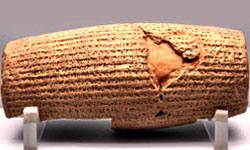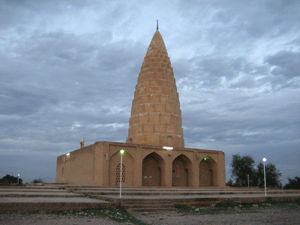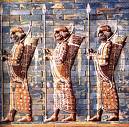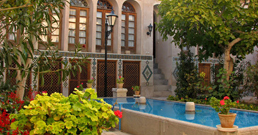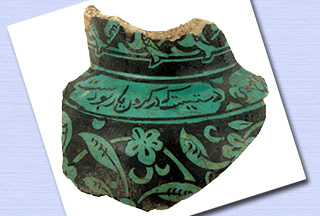|
Cyrus Charter to Be Taken Home from UK Pars News Agency TEHRAN
(FNA)- Officials from Iran National Museum are in talks with their counterparts
from the British Museum to borrow the famous Charter of the Cyrus the
Great for a few months to put it on public display at home.
The charter of Cyrus the Great, the Persian King of 539 B.C. is a baked-clay Aryan language (Old Persian) cuneiform cylinder that was discovered in 1878 in an excavation operation in the site of Babylon. The Persian King described in the charter his humane treatment of the inhabitants of Babylonia after its conquest by the Iranians. The document has been hailed as the first charter of human rights, and in 1971 the United Nations published a translation of it in all the UN official languages. The cylinder is currently housed in the British Museum and a replica of it is being kept at the United Nations headquarters in New York City. In parts of the declaration, Cyrus had said, "Until I am alive, I prevent unpaid, forced labor. To day, I announce that everyone is free to choose a religion. People are free to live in all regions and take up a job provided that they never violate other's rights." Baqaee hoped that grounds would be prepared for the transfer of the cylinder to Iran. "Cultural ties would help promote social relations among nations," Baqaee said, adding that growing cultural relations would influence nations' political and economic ties as well "although cultural issues are different from political affairs." Baqaee is in London for the inauguration of an exhibition on Iran's arts and culture during the Safavid era (1501-1732). The exhibition was inaugurated a couple of days ago at the British Museum and would continue for four months. Scores of artworks including paintings, calligraphy, China dishes, textiles and handwritten Qurans from the Safavid era were collected from 30 museums worldwide and put on display at the exhibition.
Mazandaran Inhabited 5600 Years Ago CHN
Traces
of population in Gohar Tappeh Tehran, March 10, 2009: Archeological
studies have indicated that traces of ancient population in Iran+s northern
province of Mazandaran goes back 5,600 years. The discovery has also led archeologists to believe that powerful political and economic systems in the region were established around 5,600 years ago. “If we believe in the theory that urban dwelling occurred after agrarian, we could claim settlement in Mazandaran province dates back to at least 5,600 years ago,” Mahforouzi added in a Press TV report. “We believe the powerful economic system was based on agriculture, animal husbandry, and trade - all among the basics of industry at the time,” he said. “The
history of pre-agrarian dwelling goes back to cave-dwelling era,”
Mahforouzi said. “There was a 3,800-year-old gap between cave and
agrarian dwelling in the region though.”
Yaghoob Leis Safari's resting place in Dezful - photograph: Rahim Morid
Achaemenid Sites Discovered in Western Iran CHN
Achaemenid
soldiers Tehran, March 5, 2009: Iranian archeologists have discovered
Achaemenid sites during excavations in the Khandab town of the western
Markazi Province. “This is the first excavation project in Khandab and the Achaemenid finds are the first of their kind in the western parts of Markazi Province,” said head of the archeology team Ali Asadi. “The team has found earthenware similar to the Achaemenid ones found in Fars Province,” he said. “It seems that the area had been a flourishing and prosperous site in the Achaemenid era.” Asadi believes that these areas may also include governmental road stations. Khandab
excavations have also yielded middle- and late-Islamic faience as well
as rock paintings, which are set to be studied and dated.
Sheikh Bahaee's house in Isphahan
Persian Potsherd Discovered in Israel CHN
Persian
potsherd Tehran, March 12, 2009: Israeli archeologists have unearthed
an inscribed piece of Persian pottery during excavations in the Old
City of Jerusalem (Al-Qods). Persian
Potsherd Discovered in Israel Tehran, March 12, 2009: Israeli archeologists
have unearthed an inscribed piece of Persian pottery during excavations
in the Old City of Jerusalem (Al-Qods). According to Artdaily, the piece dates back to the 12th-13th centuries CE and bears a black Persian inscription on the neck, which makes it the first of its kind to have been found in Jerusalem. The inscription has been translated by Dr. Julia Rabanovich of the Hebrew University of Jerusalem as, “Was once the embrace of a lover that entreat”. According to Rivka Cohen-Amin of the Israel Antiquities Authority, the line belongs to The Rubaiyat, a collection of quatrains (four-line poems) by the 11th-century Persian poet, mathematician and astronomer, Omar Khayyam. The following is the complete translation of the quatrain by the celebrated British translator of The Rubaiyat, Edward FitzGerald:
I think the Vessel, that with fugitive Articulation answer+d, once did live, And merry-make; and the cold Lip I kiss+d How
many Kisses might it take--and give.
|
